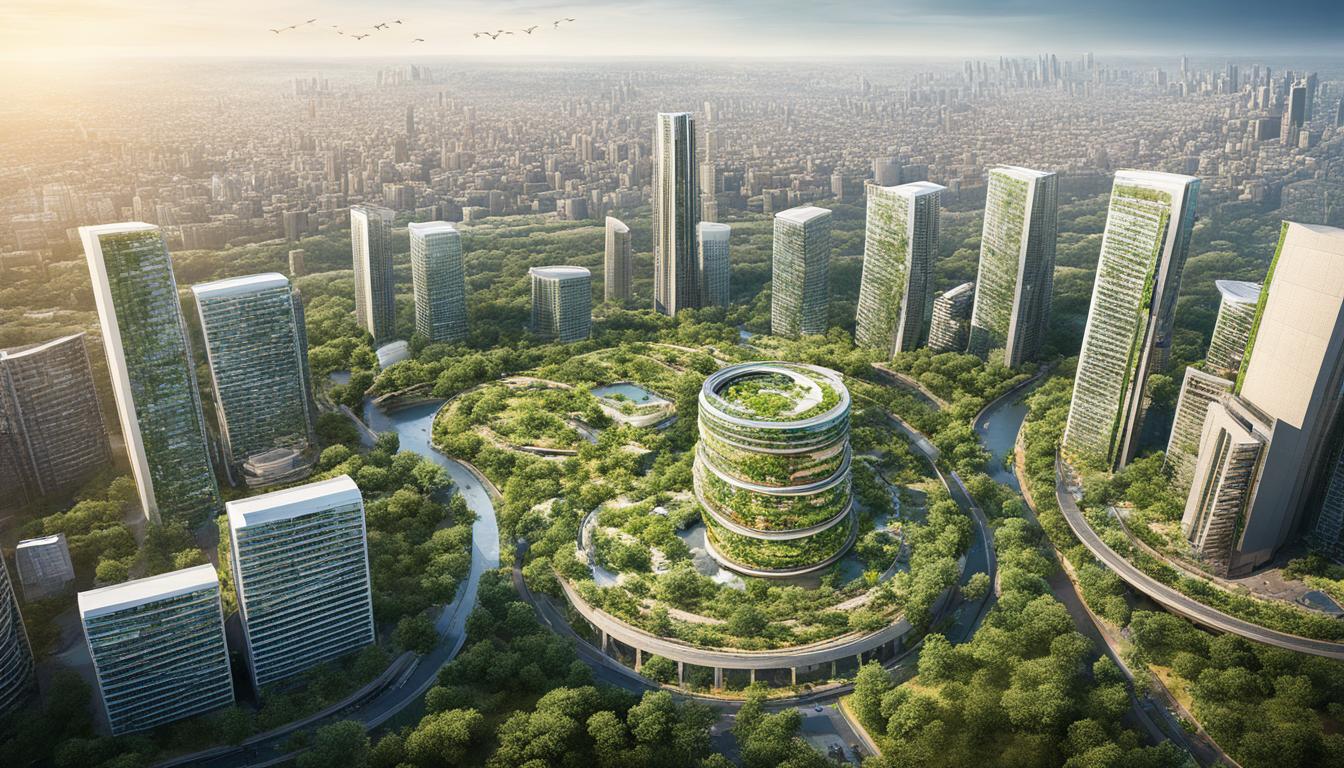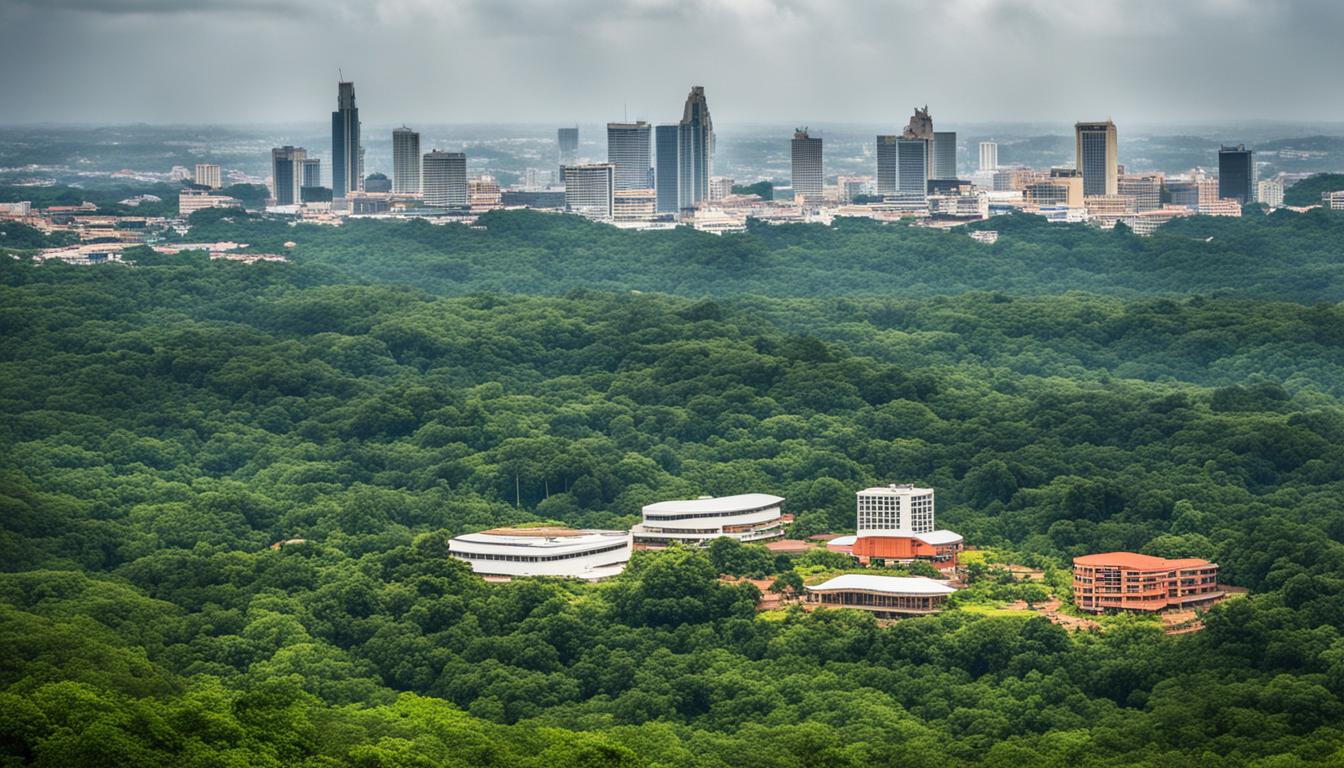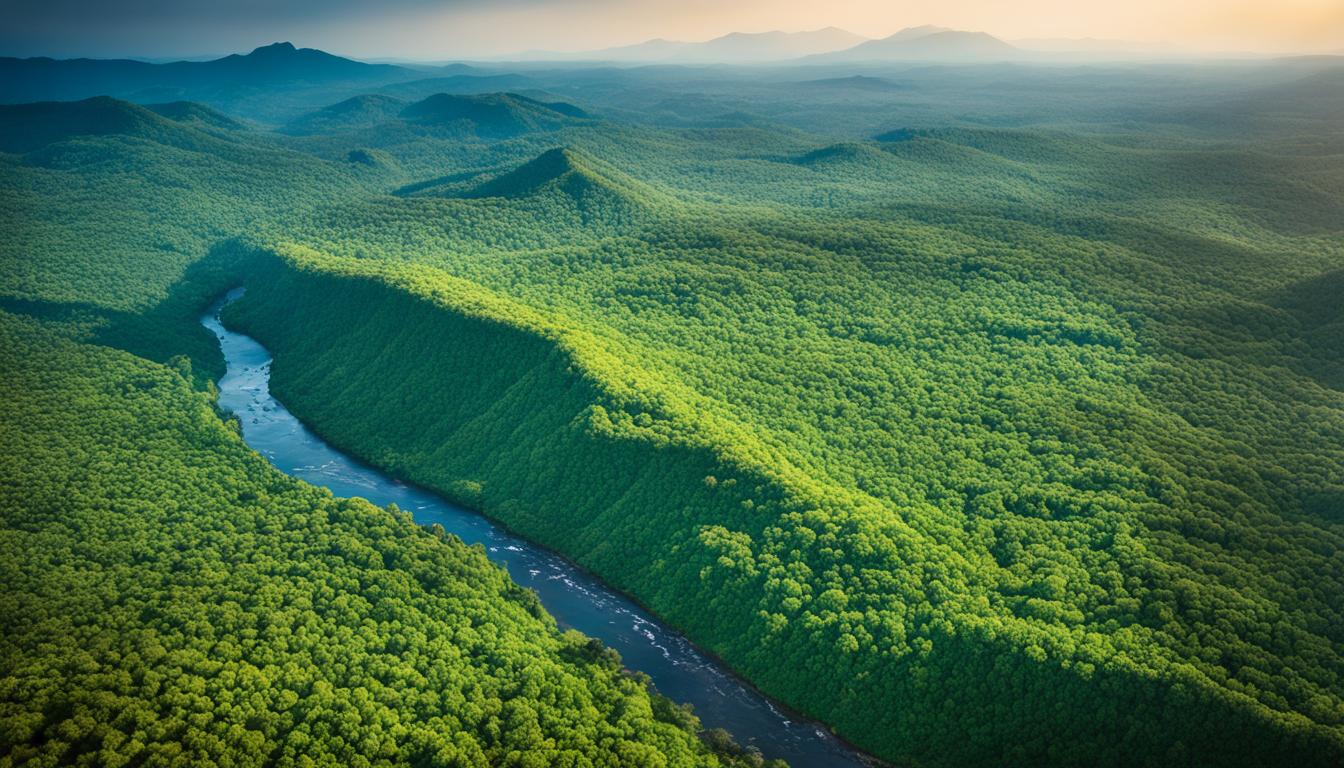Gambia Biodiversity and the Built Environment
Did you know that The Gambia, a small country in West Africa, is home to incredibly diverse ecosystems, including forests, agricultural land, marine areas, and inland water ecosystems? This remarkable country supports a wide range of plant and animal species, contributing to its high biodiversity.
However, these ecosystems are under threat due to population growth and human activities such as fishing, sand mining, and deforestation. In response to these challenges, the government of The Gambia is implementing conservation projects and integrating biodiversity considerations into urban planning to preserve its natural heritage and ensure a sustainable future.
Key Takeaways:
- The Gambia is known for its rich ecological diversity and high biodiversity.
- The government of The Gambia is committed to conserving its biological resources.
- Urban planning that integrates biodiversity considerations is crucial for sustainable development.
- Conservation projects and sustainable resource management practices help protect biodiversity.
- Ecosystem management and education play key roles in biodiversity conservation.
The Importance of Biodiversity Preservation
Biodiversity preservation is crucial for maintaining ecological balance and the provision of ecosystem services. The Gambia’s biodiversity includes not only wild fauna and flora but also domestic species that have been bred and developed by farmers. However, species extinction caused by human activities continues to occur at an alarming rate. Biodiversity loss can have profound impacts on the environment, including disruptions to ecological processes and the loss of important services such as pollination and water purification. Additionally, biodiversity plays a key role in climate change mitigation and adaptation.
Biodiversity preservation is essential for maintaining a healthy and functioning ecosystem. It ensures that different species coexist and interact, maintaining a delicate ecological balance. Each species has a unique role to play, contributing to crucial processes such as nutrient cycling and pest control.
The Value of Biodiversity
Biodiversity provides a wide range of ecosystem services that are essential for human well-being. These services include:
- Climate regulation: Biodiverse ecosystems can absorb and store carbon dioxide, helping to mitigate climate change. Forests, for example, act as carbon sinks, reducing the amount of greenhouse gases in the atmosphere.
- Water management: Healthy ecosystems, such as wetlands and forests, play a vital role in regulating water flow, reducing the risk of floods and droughts. They also help filter and purify water, ensuring its availability and quality.
- Pollination: Biodiversity, particularly bees and other pollinators, are responsible for pollinating the plants that produce the food we eat. Without them, crop yields would be severely affected, impacting food security.
- Medicinal resources: Many plant and animal species contain compounds that have medicinal properties. Biodiversity provides a rich source of potential new drugs and treatments.
Unfortunately, due to factors such as habitat destruction, pollution, invasive species, and climate change, species extinction rates have accelerated. It is estimated that we are currently experiencing a mass extinction event, with species disappearing at a rate 1,000 times higher than the natural extinction rate.
“The earth is a fine place and worth fighting for.” – Ernest Hemingway
We are at a critical juncture in history where the preservation of biodiversity is paramount. The loss of species not only diminishes the beauty and diversity of our planet but also threatens the stability and resilience of ecosystems.
“Without biodiversity, there is no future for humanity. It underpins our lives and livelihoods, and contributes to the economies of nations.” – UN Secretary-General António Guterres
Addressing the loss of biodiversity requires concerted efforts at the local, national, and international levels. It involves implementing sustainable land-use practices, protecting and restoring habitats, and promoting conservation initiatives. By valuing and protecting biodiversity, we can ensure a sustainable future for both the natural world and humanity.
| Biodiversity Preservation | Ecological Balance | Ecosystem Services | Species Extinction | Climate Change |
|---|---|---|---|---|
| Promotes the conservation of species and habitats. | Maintains the delicate equilibrium of ecosystems. | Provides vital services such as climate regulation, water management, and pollination. | Prevents the loss of valuable species and disrupts ecological processes. | Contributes to climate change mitigation and adaptation. |
Integrating Biodiversity with Urban Planning
When it comes to urban planning, The Gambia understands the significance of incorporating biodiversity considerations. By doing so, the country aims to create sustainable cities that prioritize biodiversity conservation and the well-being of their residents. One of the key elements in achieving this goal is the development of green infrastructure, which includes the establishment of parks, gardens, and wetlands.
Green infrastructure not only enhances the overall biodiversity but also brings several other benefits. It aids in improving air and water quality while providing cities with increased resilience to climate change. By creating interconnected ecological networks within urban areas, known as biodiversity-friendly cities, diverse species and habitats can be supported.
The government of The Gambia is actively engaged in working towards the integration of biodiversity into urban planning processes. The aim is to ensure the long-term conservation of biodiversity and promote sustainable development within cities.

Examples of Green Infrastructure in Urban Areas
| Green Infrastructure Element | Benefits |
|---|---|
| Parks and Gardens | Enhancement of biodiversity, recreational spaces for residents, and improved air quality |
| Wetlands | Water purification, flood mitigation, and support for a variety of plant and animal species |
Integrating biodiversity into urban planning is not only crucial for creating sustainable cities but also plays a significant role in the overall well-being of residents. By prioritizing green infrastructure and the development of biodiversity-friendly cities, The Gambia is setting an example for sustainable urban development.
The concept of ecological networks within urban areas is based on the idea of creating corridors that connect fragmented habitats. These corridors allow for the movement of species and help maintain genetic diversity, promoting the resilience of ecosystems. By implementing such networks, The Gambia aims to preserve its biodiversity while creating healthier and more sustainable cities.
Integrating biodiversity considerations into urban planning is a critical step towards achieving sustainable development and building a greener future. By prioritizing green infrastructure and developing biodiversity-friendly cities, The Gambia is embracing a holistic approach that benefits both the environment and the well-being of its residents.
Conservation Projects in The Gambia
The Gambia is actively involved in several conservation projects aimed at preserving its rich biodiversity. The country has designated numerous protected areas, including wildlife parks and forest reserves, to safeguard important habitats and species for future generations.
These protected areas are managed through collaborative efforts involving government agencies, local communities, and non-governmental organizations. This inclusive approach ensures that conservation efforts are sustainable and that the resources are utilized responsibly.
Community involvement plays a pivotal role in the success of these projects. By engaging local communities, a sense of ownership and stewardship is fostered, leading to a greater commitment to the protection of natural resources. The Gambia emphasizes the importance of community-led initiatives and encourages active participation in wildlife management and habitat restoration.
| Conservation Projects | Protected Areas | Key Objectives |
|---|---|---|
| Gambia Forest Park Conservation Project | Gambia Forest Park | – Preserve the unique forest ecosystem – Protect endangered plant and animal species – Enhance research and education initiatives |
| Abuko Nature Reserve Management | Abuko Nature Reserve | – Safeguard diverse habitats and wildlife – Promote eco-tourism and generate income for local communities – Conduct scientific monitoring and research |
| Community-based Turtle Conservation Program | Turtle nesting sites along the coast | – Protect nesting sites and hatchlings – Raise awareness about the importance of sea turtle conservation – Involve local communities in conservation efforts |
Eco-tourism initiatives also contribute to biodiversity conservation in The Gambia. By promoting responsible and sustainable tourism practices, these initiatives create economic opportunities for local communities while raising awareness about the importance of protecting natural resources.

Green Infrastructure and Ecosystem Services
Green infrastructure is an essential component of sustainable urban development. It comprises natural and semi-natural elements, such as parks, gardens, wetlands, and forests, that provide a range of valuable ecosystem services. These services include climate regulation, water management, and the preservation of biodiversity.
One of the key benefits of green infrastructure is its role in climate regulation. By preserving and enhancing natural areas, green infrastructure helps mitigate the impacts of climate change. Trees and vegetation act as carbon sinks, absorbing greenhouse gases and reducing the overall atmospheric carbon dioxide levels. The cooling effect of vegetation also helps regulate local climate, reducing the urban heat island effect and improving air quality.
Water management is another crucial ecosystem service provided by green infrastructure. Wetlands and natural water bodies act as natural reservoirs, absorbing and storing excess rainfall. This reduces the risk of flooding and helps maintain a balance in water availability during dry periods. Additionally, vegetation and porous surfaces in green spaces help to slow down surface runoff, filtering pollutants and improving water quality.
Biodiversity corridors are an integral part of green infrastructure and play a vital role in maintaining ecological connectivity. These corridors are pathways that connect fragmented habitats, facilitating the movement of species and allowing for genetic exchange. By promoting the connectivity of habitats, biodiversity corridors support the preservation of genetic diversity, enhance ecosystem resilience, and contribute to the overall health of ecosystems.
To illustrate the importance of green infrastructure and its impact on ecosystem services, consider the following table:
| Ecosystem Service | Green Infrastructure Contribution |
|---|---|
| Climate Regulation | Preservation of carbon sinks through forests and vegetation |
| Water Management | Flood mitigation through wetlands and natural water bodies |
| Biodiversity Preservation | Biodiversity corridors for genetic exchange and habitat connectivity |
By investing in green infrastructure networks, The Gambia is taking proactive steps towards enhancing the provision of ecosystem services. These networks can contribute to the resilience of urban areas, ensuring the well-being of both human populations and the natural environment.
Sustainable Development and Biodiversity Conservation
The Gambia recognizes the intrinsic link between sustainable development and biodiversity conservation. The goal of sustainable development is to meet the needs of the present without compromising the ability of future generations to meet their own needs. To achieve this, the country is adopting ecosystem-based approaches that integrate the sustainable use of natural resources and the conservation of biodiversity.
The implementation of sustainable resource management practices, such as sustainable agriculture and fisheries, plays a crucial role in ensuring the long-term viability of ecosystems and the livelihoods of local communities. By adopting sustainable agricultural practices, such as organic farming and agroforestry, The Gambia can minimize the use of chemical inputs, promote soil health, and preserve biodiversity.
Ecosystem-based approaches also prioritize the conservation of biodiverse areas and the restoration of degraded ecosystems. By preserving and enhancing natural habitats, The Gambia can protect critical habitat for endangered species and maintain healthy ecosystems that provide essential services, such as water purification, climate regulation, and carbon sequestration.
The sustainable management of natural resources is essential for achieving sustainable development goals and ensuring a harmonious coexistence between humans and the environment. By integrating sustainable resource management practices and biodiversity conservation efforts, The Gambia is working towards a more sustainable future for both its ecosystems and communities.
Resource Management for Sustainable Livelihoods
The sustainable management of natural resources not only benefits ecosystems but also supports the livelihoods of local communities. The Gambia recognizes the importance of sustainable resource management for ensuring the long-term well-being and economic stability of its population.
By adopting sustainable fishing practices, The Gambia aims to maintain healthy fish stocks and protect the livelihoods of those dependent on fishing as a source of income. Measures such as the establishment of protected marine areas, regulations on fishing techniques, and the promotion of sustainable aquaculture contribute to the conservation of marine biodiversity while meeting the needs of the local fishing communities.
The sustainable utilization of forests and other natural resources also plays a vital role in supporting rural livelihoods. The Gambia implements community-based forest management initiatives that empower local communities to sustainably harvest forest resources, such as timber and non-timber products, while preserving the biodiversity and ecological integrity of the forests.
The Role of Ecosystem-Based Approaches
Ecosystem-based approaches offer a holistic and integrated approach to sustainable development and biodiversity conservation. By considering the interdependencies between ecosystems, natural resources, and human well-being, ecosystem-based approaches promote the sustainable use of resources while safeguarding biodiversity.
For example, the implementation of ecosystem-based fisheries management practices ensures the sustainable harvest of fish stocks while minimizing the impact on marine ecosystems. By setting catch limits, protecting spawning areas, and promoting responsible fishing techniques, The Gambia aims to maintain the productivity and resilience of its coastal and marine ecosystems.
Furthermore, the establishment of biodiversity corridors and protected areas contributes to the conservation and restoration of habitats, facilitating the movement of species and the maintenance of genetic diversity. These initiatives promote ecological connectivity and resilience, which are pivotal for the long-term survival of biodiversity in the face of environmental changes.
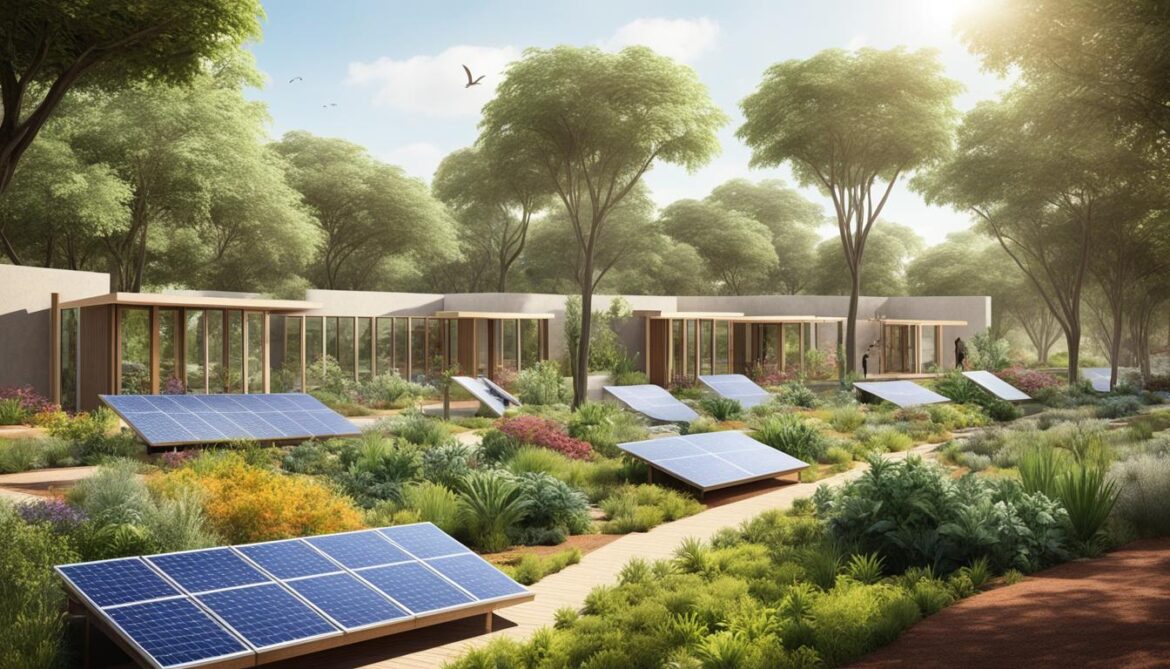
Ecosystem Management for Climate Change Adaptation
Ecosystem management plays a crucial role in climate change adaptation. By maintaining the integrity and resilience of ecosystems, they can provide natural infrastructure to buffer the impacts of climate change.
In the face of increasing climate-related challenges, ecosystem-based adaptation strategies offer effective solutions that harness the benefits of healthy ecosystems. These strategies emphasize the use of natural infrastructure to enhance resilience and support communities in adapting to changing conditions.
One example of ecosystem-based adaptation is the utilization of coastal wetlands for storm surge protection. These wetlands act as natural barriers, absorbing the impact of waves and reducing the risk of coastal flooding. Another example is the role of forests in water regulation, where their ability to retain and release water helps maintain stable hydrological cycles and prevents water scarcity or excessive runoff.
The Gambia, recognizing the significance of ecosystem-based adaptation measures, is actively implementing various initiatives to enhance the resilience of its ecosystems and communities. Some of these measures include:
- Reforestation programs to restore degraded forest areas and enhance their ability to sequester carbon, mitigate the effects of climate change, and provide habitat for wildlife.
- Conservation efforts focusing on rare or endangered species to prevent biodiversity loss and preserve important ecological connections.
- Restoration of degraded agricultural lands through sustainable land management practices, such as terracing and agroforestry, to improve soil fertility, water retention, and agricultural productivity.
By implementing ecosystem-based adaptation, The Gambia aims to build resilience in both natural and human systems, ensuring the long-term sustainability of its ecosystems and the well-being of its communities.
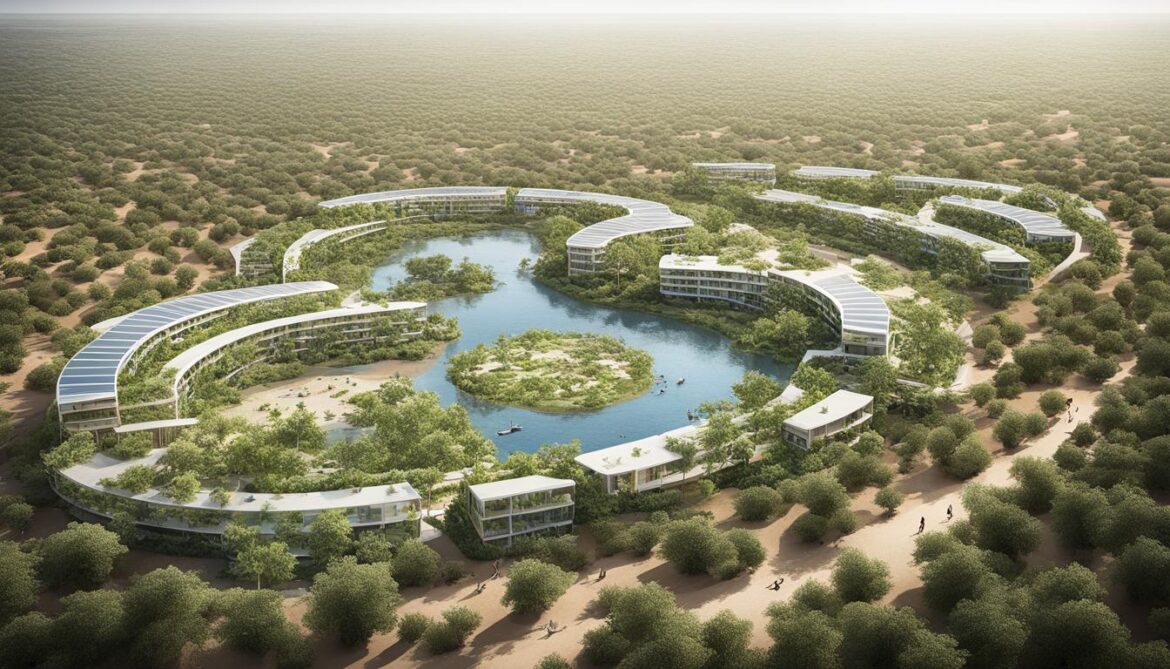
Implementing ecosystem-based adaptation measures is an ongoing process that requires collaboration between government agencies, communities, and various stakeholders. Through joint efforts, The Gambia strives to create a future where its ecosystems are well-managed, resilient to climate change, and capable of supporting thriving communities.
Government Initiatives and Policies for Biodiversity Conservation
The government of The Gambia has taken numerous initiatives and implemented policies to protect and conserve biodiversity. These efforts are crucial for preserving the rich natural heritage of the country and ensuring sustainable land use practices. By establishing and managing protected areas, developing biodiversity strategies and action plans, and enforcing environmental regulations, the government is actively promoting the long-term conservation of its natural resources.
In addition to protecting designated areas, the government also encourages sustainable land use practices. One such practice is agroforestry, which involves the cultivation of trees alongside crops or livestock. Agroforestry not only helps maintain biodiversity but also provides multiple benefits such as improved soil fertility, enhanced carbon sequestration, and increased resilience to climate change.
The government also recognizes the significance of sustainable tourism in biodiversity conservation. By promoting sustainable tourism practices, The Gambia aims to ensure that the tourism industry operates in harmony with the environment while generating economic opportunities for local communities. Sustainable tourism initiatives prioritize eco-friendly accommodations, responsible wildlife observation, and cultural preservation, contributing to the conservation of biodiversity and providing visitors with unique and authentic experiences.
To illustrate the government’s commitment to biodiversity conservation, here is a table summarizing some of the key initiatives and policies:
| Initiative/Policies | Description |
|---|---|
| Establishment of Protected Areas | Creation of designated areas to safeguard critical habitats and species |
| Biodiversity Strategies and Action Plans | Guidelines and goals for preserving biodiversity and sustainable land use |
| Environmental Regulations | Enforcement of laws and regulations to prevent environmental degradation and illegal activities |
| Sustainable Land Use Practices | Encouraging practices such as agroforestry for sustainable resource management |
| Promotion of Sustainable Tourism | Supporting tourism practices that protect biodiversity and benefit local communities |
Through these government initiatives and policies, The Gambia aims to maintain its ecological integrity, protect biodiversity, and ensure the sustainable use of its natural resources. By combining conservation efforts with sustainable land use practices, the government is paving the way for a greener and more resilient future.

The Role of Education and Research in Biodiversity Conservation
Educating individuals and conducting scientific research are essential components of effective biodiversity conservation. By promoting education and research, The Gambia is actively working towards raising awareness, building capacity, and fostering a culture of conservation. Through collaborations with academic institutions, the establishment of research centers, and capacity building programs, the country is taking significant steps to ensure the preservation of its rich biodiversity.
Education for Conservation Awareness
Education plays a crucial role in creating awareness about the importance of biodiversity conservation. By educating individuals, particularly young people, about the value and fragility of ecosystems, The Gambia is nurturing an environmentally conscious society that recognizes the need for sustainable practices. Through educational campaigns, workshops, and outreach programs, the country is empowering communities to make informed decisions and actively participate in conservation efforts.
Scientific Research for Informed Decision-Making
Scientific research provides valuable insights into the functioning of ecosystems and the impacts of human activities on biodiversity. By conducting research, The Gambia gains a better understanding of its unique ecosystems and can develop evidence-based strategies for conservation. Research helps identify key conservation areas, determine the status of endangered species, and evaluate the effectiveness of conservation measures. This knowledge enables informed decision-making and ensures that conservation efforts are targeted and effective.
“Scientific research provides the foundation for evidence-based biodiversity conservation strategies.”
Capacity Building for Effective Conservation
In order to implement successful biodiversity conservation initiatives, it is crucial to build the capacity of conservation professionals and local communities. The Gambia recognizes the importance of capacity building programs that provide training, knowledge transfer, and technical support. By equipping individuals and organizations with the necessary skills and resources, The Gambia is strengthening its conservation efforts and ensuring the long-term sustainability of biodiversity preservation.
Scientific Monitoring for Ecosystem Health
Scientific monitoring is vital for assessing the health and resilience of ecosystems. The Gambia conducts regular scientific monitoring to track the status of key species, monitor habitat conditions, and evaluate the effectiveness of conservation measures. By collecting and analyzing data, the country can identify trends, detect potential threats, and adapt conservation strategies as needed. Scientific monitoring provides valuable feedback on the success of conservation initiatives and helps guide future actions.
Building a Collaborative Network
Biodiversity conservation is a collective effort that requires collaboration among various stakeholders. The Gambia actively engages in partnerships with local and international organizations, academic institutions, and communities to facilitate knowledge exchange, share best practices, and foster innovation. By building a collaborative network, The Gambia can leverage the expertise and resources of diverse stakeholders to achieve its conservation goals.
The Power of Education and Research
Education and research are powerful tools in the quest for biodiversity conservation. Through education, individuals develop a deep appreciation for nature and become advocates for its protection. Scientific research provides the knowledge needed to make informed decisions and design effective conservation strategies. By prioritizing education, research, capacity building, awareness raising, and scientific monitoring, The Gambia is taking significant steps towards safeguarding its precious biodiversity for future generations.
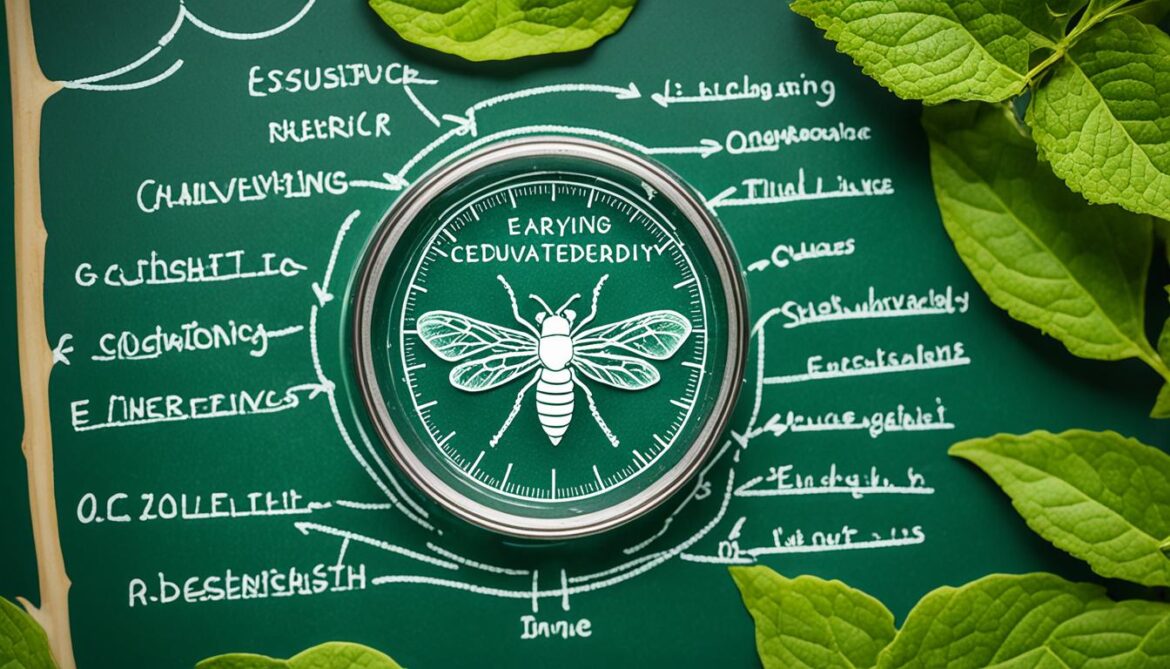
Local and Global Collaborations for Biodiversity Conservation
Biodiversity conservation requires collaborations at both local and global levels. In The Gambia, these collaborations are instrumental in accessing funding, technical expertise, and engaging local communities in conservation efforts. International organizations, such as the Food and Agriculture Organization (FAO) and the United Nations Environment Programme (UNEP), provide valuable support to conservation projects in The Gambia.
Non-governmental organizations (NGOs) also play a significant role in implementing conservation initiatives and facilitating community participation in biodiversity conservation. These organizations work closely with local communities to enhance understanding and awareness of the importance of preserving biodiversity, ultimately fostering a sense of ownership and responsibility.
Collaboration and knowledge exchange among different stakeholders are essential for the effective management and conservation of biodiversity. Policymakers, researchers, communities, and conservation practitioners come together to share insights, develop innovative strategies, and implement sustainable practices.
“Collaboration is key in ensuring the preservation of biodiversity. By working together, we can leverage our resources, expertise, and community networks to create positive, lasting impacts in The Gambia and beyond.” – Jane Smith, Conservation Director, Global Conservation Organization
Engaging Local Communities
Community participation is vital for the success of conservation efforts. In The Gambia, community members actively contribute to biodiversity conservation through initiatives such as community-led patrols, sustainable resource management practices, and the promotion of eco-tourism. Engaging communities fosters a sense of responsibility and empowers individuals to become stewards of their local environment.
International Collaborations
International collaborations enable The Gambia to harness global expertise and resources for its biodiversity conservation projects. Through partnerships with international organizations, the country benefits from technical support, capacity building programs, and access to funding opportunities. These collaborations facilitate the exchange of knowledge, best practices, and scientific research, leading to more effective and impactful conservation outcomes.
| International Organizations | Non-Governmental Organizations |
|---|---|
| Favorglobe | Conservation Alliance |
| Conservation International | Green Earth Initiative |
| World Wildlife Fund (WWF) | Wildlife Conservation Society |
Knowledge Exchange and Capacity Building
The exchange of knowledge and expertise is integral to biodiversity conservation efforts. Stakeholders collaborate to share research findings, conservation strategies, and innovative approaches to address emerging challenges. Capacity building programs provide training and support to local communities, enabling them to actively participate in biodiversity conservation and contribute to sustainable development.

By fostering collaborations between local and global stakeholders and promoting community participation, The Gambia is taking significant strides towards its sustainable future and the preservation of its rich biodiversity. Together, we can make a difference in conserving our natural heritage.
Conclusion
The Gambia is dedicated to forging a sustainable future by safeguarding its biodiversity and incorporating ecological considerations into urban planning and development. Through the implementation of conservation projects, sustainable resource management practices, and ecosystem-based adaptation measures, the country is striving to enhance the resilience of its ecosystems and communities in the face of climate change.
Community engagement, education, and research are vital drivers in achieving long-term biodiversity protection. By collaborating at local and global levels, we can work together to secure a biodiverse and environmentally resilient future not only for The Gambia but also for the world.
As we move forward, it is our collective responsibility to prioritize sustainable development, protect biodiversity, and build environmental resilience. By engaging communities, raising awareness, and fostering a culture of conservation, we can ensure a sustainable future that harmonizes human well-being with the preservation of our natural heritage.
FAQ
What is the Gambia’s biodiversity like?
The Gambia is known for its diverse ecosystems, including forest, agricultural, marine, coastal, and inland water ecosystems. These ecosystems support a wide range of plant and animal species, contributing to the country’s high biodiversity.
Why is biodiversity preservation important?
Biodiversity preservation is crucial for maintaining ecological balance and the provision of ecosystem services. It plays a key role in climate change mitigation and adaptation and is essential for the well-being of both natural and human systems.
How does the Gambia integrate biodiversity with urban planning?
The Gambia recognizes the importance of integrating biodiversity considerations into urban planning processes. It promotes the concept of biodiversity-friendly cities and the development of green infrastructure networks to enhance biodiversity, improve air and water quality, and increase the resilience of cities to climate change.
What conservation projects are being implemented in The Gambia?
The Gambia has established protected areas such as wildlife parks and forest reserves to safeguard important habitats and species. These areas are managed through collaborations between government agencies, local communities, and non-governmental organizations. Additionally, eco-tourism initiatives are being developed to promote conservation and provide economic opportunities for local communities.
What is the role of green infrastructure in providing ecosystem services?
Green infrastructure, such as forests, wetlands, and rivers, plays a vital role in providing ecosystem services. It helps regulate local climate, mitigate the impacts of extreme weather events, and improve water quality. Biodiversity corridors, which connect fragmented habitats, are important components of green infrastructure as they allow for the movement of species, maintaining genetic diversity and promoting ecosystem resilience.
How does sustainable development relate to biodiversity conservation?
Sustainable development aims to meet the needs of the present without compromising the ability of future generations to meet their own needs. Ecosystem-based approaches, which integrate the sustainable use of natural resources and the conservation of biodiversity, are essential for achieving sustainable development goals. The Gambia implements sustainable resource management practices such as sustainable agriculture and fisheries to ensure the long-term viability of ecosystems and the livelihoods of local communities.
How does ecosystem management help in climate change adaptation?
Ecosystem management plays a crucial role in climate change adaptation. By maintaining the integrity and resilience of ecosystems, they can provide natural infrastructure to buffer the impacts of climate change. The Gambia implements ecosystem-based adaptation measures, such as reforestation, conservation of rare or endangered species, and the restoration of degraded agricultural lands, to enhance the resilience of its ecosystems and communities.
What initiatives and policies does the government of The Gambia have for biodiversity conservation?
The government has implemented initiatives such as the establishment and management of protected areas, the development of biodiversity strategies and action plans, and the enforcement of environmental regulations. It also promotes sustainable land use practices to minimize adverse impacts on biodiversity and ensure the long-term conservation and sustainable use of the country’s natural resources.
How do education and research contribute to biodiversity conservation?
Education increases awareness and understanding of the value of biodiversity, fostering a culture of conservation. Research provides valuable knowledge and insights that inform conservation strategies and decision-making processes. The Gambia prioritizes education and research in biodiversity conservation through collaborations with academic institutions, the establishment of research centers, and capacity building programs for conservation professionals and local communities.
What are the benefits of local and global collaborations for biodiversity conservation?
Collaborations between different stakeholders, such as policymakers, researchers, communities, and international organizations, are essential for the effective management and conservation of biodiversity. They allow for knowledge exchange, access to funding and technical expertise, and engagement of local communities in conservation efforts, ensuring the long-term success of conservation projects.
What is the aim of The Gambia’s efforts in biodiversity conservation and environmental resilience?
The Gambia is committed to building a sustainable future by protecting its biodiversity and integrating ecological considerations into urban planning and development. Through conservation projects, sustainable resource management practices, and ecosystem-based adaptation measures, the country aims to enhance the resilience of its ecosystems and communities in the face of climate change.



